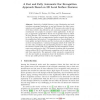Free Online Productivity Tools
i2Speak
i2Symbol
i2OCR
iTex2Img
iWeb2Print
iWeb2Shot
i2Type
iPdf2Split
iPdf2Merge
i2Bopomofo
i2Arabic
i2Style
i2Image
i2PDF
iLatex2Rtf
Sci2ools
ACIVS
2008
Springer
2008
Springer
A Fast and Fully Automatic Ear Recognition Approach Based on 3D Local Surface Features
Sensitivity of global features to pose, illumination and scale variations encouraged researchers to use local features for object representation and recognition. Availability of 3D scanners also made the use of 3D data (which is less affected by such variations compared to its 2D counterpart) very popular in computer vision applications. In this paper, an approach is proposed for human ear recognition based on robust 3D local features. The features are constructed on distinctive locations in the 3D ear data with an approximated surface around them based on the neighborhood information. Correspondences are then established between gallery and probe features and the two data sets are aligned based on these correspondences. A minimal rectangular subset of the whole 3D ear data only containing the corresponding features is then passed to the Iterative Closest Point (ICP) algorithm for final recognition. Experiments were performed on the UND biometric database and the proposed system achiev...
| Added | 12 Oct 2010 |
| Updated | 12 Oct 2010 |
| Type | Conference |
| Year | 2008 |
| Where | ACIVS |
| Authors | Syed M. S. Islam, Rowan Davies, Ajmal S. Mian, Mohammed Bennamoun |
Comments (0)

